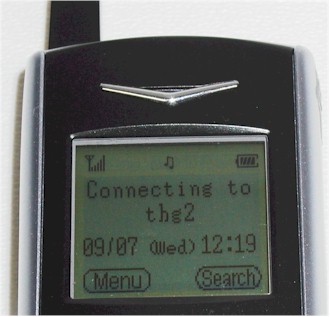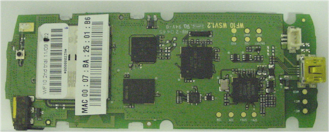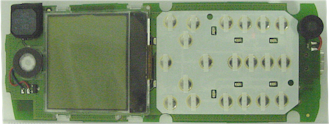The Pitch and Product

| Vonage Wi-Fi Handset | |
|---|---|
| Summary | OEM’d UTStarcom F1000 locked to Vonage service. |
| Update | None |
| Pros | • A one-stop portable VoIP solution |
| Cons | • Difficult to set up for encrypted APs • Menu system is somewhat counter-intuitive |
So you have a Wi-Fi network and want to quickly get on the VoIP bandwagon without having to rework your network? Or want a VoIP phone that can travel, without having to take apart your own network just to bring your phone with you?
Vonage has a great idea, but as yet poorly realized with its Wi-Fi handset. It looks like an ordinary cell phone but it has the ability to glom on to your Wi-Fi signal so you can use it wherever you can find an open access point.
The handset is actually a UTStarcom F1000 phone (Figure 1) that weighs about four ounces and is about the size of a largish cell phone.
Figure 1: Vonage Wi-Fi Phone
(click image to enlarge)
Figures 2 and 3 show views of the back and front of the phone’s circuit board. They’re pretty fuzzy, but if you look closely, you can see part of the Agere logo under the radio module labels to the left of Figure 2. The pictures don’t have enough resolution to determine the processor used.
Figure 2: Board rear view
(click image to enlarge)
Figure 3: Board front view
(click image to enlarge)
Vonage isn’t the first to offer such a device, which go under the moniker of WiSIP or VoWLAN phones. Zyxel offers its Prestige 2000W model [reviewed here] and Siemens has recently introduced its Gigaset SL75.
Unfortunately, the product, which is still in beta, has its quirks. Battery life is abysmal, configuring the phone will give you fits, and if your AP has any security features enabled you will have trouble getting connected.
The Test and Verdict
Setup is simple – you unpack the phone, charge it, and then turn it on. If an AP is within reach and unencrypted, it will automatically acquire the signal, establish a session and be ready to make and receive calls with its assigned phone number (Figure 4). During the Beta period, Vonage is only supporting a few area codes in major metro areas around the US, but will support all its normal codes when the product ships in October.

Figure 4: Associating with an AP
If you want to connect to a specific AP, or to set up particular Wi-Fi parameters, you’ll need to study the menus and the manual, because the phone doesn’t give you much guidance. And the manual isn’t much help either, with just a few pages covering these critical steps.
Oh and by the way, did I mention that it supports 802.11b only? While this older standard has plenty of speed to support the phone’s 100kbps or so bandwidth requirements, its use on an 11g WLAN will cause general throughput degradation for all clients on the AP that the phone associates with. This isn’t a problem with the phone itself, but due to the way that 11g has to accommodate slower 11b devices.
Charging time for the phone was three hours from a complete discharge, but the battery life on standby lasted only eight hours, a stark contrast to the 50 -100 hours claimed on the phone’s preliminary data sheet from Vonage. And any talk time drained the battery at a rate such that I find the five hour talk time also claimed on the spec sheet to be overly optimistic. This is not a phone for chatty Cathys.
Call quality was about on par with your average cell phone, which is to say that most of my conversations were punctuated with “What?” and “Can you hear me now?”.
One of the biggest weaknesses is call handling in marginal coverage areas. Unlike ordinary cordless phones that warn you when you are walking out of range, the calls simply drop off into the ether, as if you stepped into a black hole. Reacquiring your signal might take rebooting your phone. Rebooting your phone? Yes, that is what it feels like. Luckily, the phone doesn’t take as long to restart as your average PC, but turning it off and on again is awkward.
If you are left-handed, you will dig the menus, which have the “OK” or enter key on the left, rather than on the right-hand button where most of us are used to seeing them on regular phones with on-screen menus. The cell-like features (address book, calling lists, ring tones, and ring styles) are somewhat stunted and sparse, but the phone supports three-way calling, call waiting and call transfers – as long as you remember to use the left-hand button to confirm your choices, that is. I also found that if you use the phone to interact with various touch-tone services (like your bank or airline reservation systems, or your own voice mail), you may find your commands being misinterpreted or sometimes even ignored entirely.
If you are used to having the sexiest cell around, this clearly isn’t it. My teenage daughter, certainly an arbiter of cell taste, turned up her nose at the sight of the phone’s clunky features. It lasted in her hands a matter of minutes – clearly, the phone doesn’t have anywhere near the cool factor of the Razr phones. But for those of us who don’t really need another electronic gizmo as fashion statement, it is a workable phone.
For the time being, if you want untethered VoIP service at your home or office you would be better served by investing in a standard VoIP terminal adapter and account, and buying an ordinary cordless phone from your local office supplier. If you need a VoIP phone-to-go, use Vonage’s SoftPhone client or better yet, just invest in a free Skype account that will work on your laptop.



